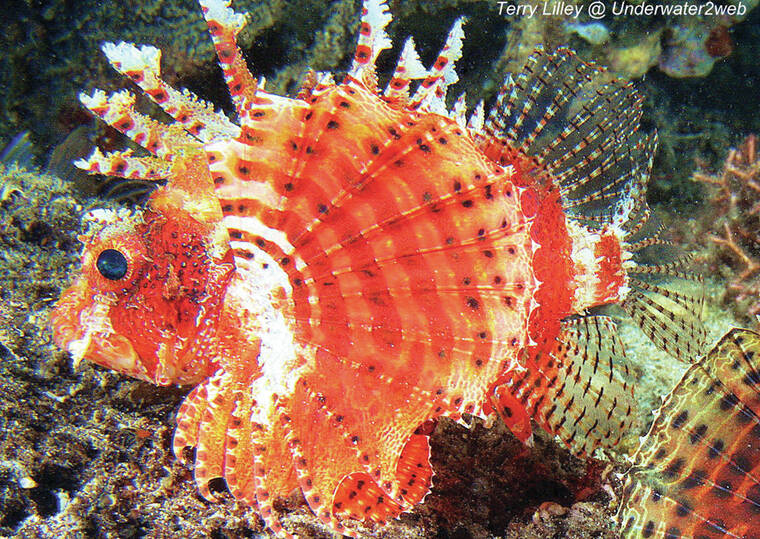While out snorkeling I often point out a fish on the reef to a tourist that looks just like a stone. Most divers swim right over these fish and never see them. I hope to educate divers to look out for these camouflaged predators because they are extremely painful if you get stung by them. On a snorkel at Anini beach in Kaua‘i, I saw a person stand up on the reef barefoot and they had two extremely poisonous fish within inches of their toes that could have send them to the emergency room.
Scorpion fish fish live in most of the world’s oceans, but they are the hardest fish to find because they do not normally swim. They sit motionless on the reef and wait for small fish to swim by that they gulp down with lightning speed. These fish grow up to a foot long and are very common, but people do not see them because they look like a rock covered in algae. They have irregular growths on their skin that look like seaweed and some species even grow live seaweed on their skin.
What gives the fish away is when you come very close to standing on one they spread their pectoral fins and swim a short distance away, then stop and remain motionless again. Their pectoral fins are brightly colored and in the marine animal world bright colors often mean danger. Divers will often tell me that they were looking at a rock and all of a sudden the rock flashed bright yellow and red colors.
It is amazing that there are scorpion fish on reefs in the Philippines, Hawai‘i, Mexico, Indonesia and Australia that all look very similar and they all have the same behaviour. They try to remain camouflaged and don’t normally move, but when frightened they flash their beautifully colored pectoral fins as a warning to stay away.
At the base of the fins on the scorpion fish are poison sacs and when the fin is erect it can stab into your flesh. Muscles in the fish inject the poison down a groove in the spine much like a poisonous snake does with its teeth.
If you get stung by this fish you won’t die, but you may wish you had as the pain can be extreme and last for many hours. It is best if stung to soak the area in hot water for an hour or so as the heat breaks down the venom. If stung it is always best to seek medical attention because the venom can cause nausea, cramps and with some species can even be deadly.
One of the reasons I like to inform divers to never touch the reef without gloves on and snorkelers to never stand on the reef is because I did just that and got stung by a lion fish. It hurt for 12 hours even more than when I got bitten by a rattlesnake in California. If you see flashing bright colors underwater much like a flashing red stop light on the road, that means stop and don’t get any closer.
Pay attention to these fish and learn what they look like as that may just keep your snorkel or dive a happy experience. Scorpion fish come in many different shapes and patterns, but they all have brightly colored fins as a warning to stay away from them.
Hawaiian devil scorpion fish with yellow and red pectoral fins.
Indonesian lion fish with bright orange pectoral fins.
•••
Terry Lilley is a marine biologist living in Hanalei Kaua‘i and co-founder of Reef Guardians Hawai‘i, a nonprofit on a mission to provide education and resources to protect the coral reef. To donate to Reef Guardians Hawaii go to www.reefguardianshawaii.org.






